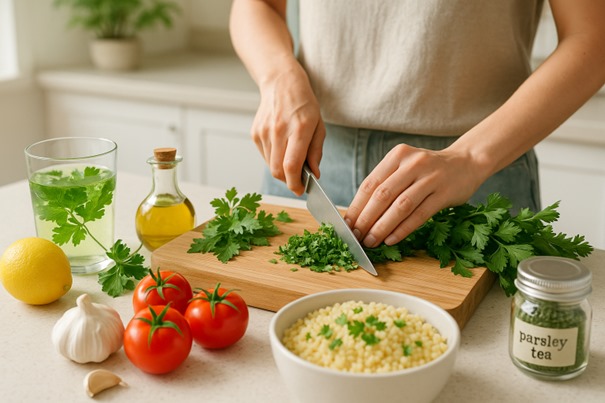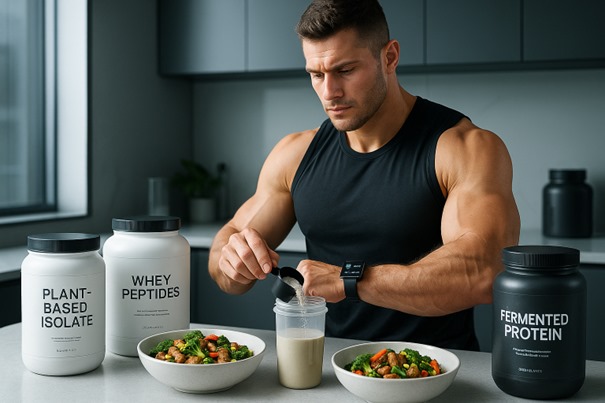In a culinary world obsessed with kale, avocado, and turmeric lattes, parsley has remained curiously unpopular — especially in the United States. Despite being rich in nutrients and flavor, this vibrant green herb is often misunderstood, underused, or outright avoided. While many cultures embrace parsley as a daily staple, in America it's frequently dismissed as nothing more than a garnish, doomed to be scraped off the side of a plate.
But what if this humble herb was actually one of the most powerful and affordable ingredients for improving your health?
As interest in plant-based nutrition and functional foods continues to rise, more dietitians and researchers are turning their attention back to parsley — and discovering that it deserves a permanent place in any well-balanced diet.
A Nutritional Powerhouse in Disguise
Parsley (Petroselinum crispum) might look delicate, but its nutritional profile is anything but. Just half a cup of fresh parsley provides:
- Over 100% of your daily vitamin K
- More vitamin C than a small orange
- Significant levels of vitamin A, folate, calcium, and iron
- Powerful antioxidants like luteolin, apigenin, and myristicin
These compounds don't just boost your immune system — they help reduce inflammation, protect your cells from oxidative stress, and may even lower your risk of chronic diseases such as cancer and heart disease.
"Parsley is incredibly nutrient-dense for something people typically ignore," says Dr. Leah Mitchell, a clinical dietitian based in Chicago. "It's one of the easiest ways to improve the micronutrient quality of a meal without changing its flavor dramatically."
Detoxification, Digestion, and Water Retention
Parsley is more than just a vitamin source — it also acts as a functional herb. Thanks to its natural diuretic properties, parsley can help the body eliminate excess water and sodium, supporting kidney health and reducing bloating.
Its high chlorophyll content has been linked to liver detoxification processes, while the bitter compounds in its leaves can stimulate digestion and bile production — especially useful after heavy meals or diets high in fats.
Many health-conscious consumers now blend parsley into juices or teas as a natural remedy for water retention, digestion issues, or simply to boost overall vitality.
Why Americans Don't Like It
Despite its benefits, parsley is often unpopular in the American diet. For many, the flavor is too "green," too "bitter," or simply unfamiliar. There's also a long-standing cultural stigma around parsley being a decoration, not an ingredient.
In mid-century American dining, parsley was often placed as a raw sprig next to a steak or mashed potatoes — not intended to be eaten. Over time, this turned into a perception problem: parsley wasn't food, it was plate filler.
"This was a case of marketing gone wrong," says culinary historian Patrick Sanders. "Instead of promoting it as a healthful ingredient, we made it look like plastic grass."
Add to that a general trend toward salt, sugar, and fat-heavy meals — and it's no surprise that parsley's fresh, earthy bite never quite fit in with the American palate.
A Quiet Comeback Through Clean Eating
Today, however, as awareness grows around processed food and the importance of whole ingredients, parsley is enjoying a quiet revival. It's showing up in smoothie bowls, vegan soups, roasted vegetable platters, and herb-based sauces like chimichurri and gremolata.
Athletes and health influencers have begun praising its anti-inflammatory effects. Meal prep enthusiasts now chop parsley in bulk to add color, freshness, and nutrients to rice, pasta, and lentil dishes. Even parsley water — a steeped herbal infusion — is gaining traction on wellness platforms as a daily detox ritual.
Its flavor may still divide opinions, but parsley's versatility makes it easy to incorporate gradually, even for hesitant eaters.
How to Start Adding Parsley Without Hating It
If you're unfamiliar with parsley or still associate it with bitter salads or awkward sprigs, the key is balance:
- Mix chopped parsley with lemon juice and olive oil to make a quick, zesty dressing.
- Add it at the end of cooking to avoid bitterness — never boil it.
- Blend it with garlic into a green sauce for meat, fish, or grilled vegetables.
- Sprinkle a tablespoon into scrambled eggs or cooked grains for color and depth.
- Try Italian flat-leaf parsley, which has a milder flavor than curly types.
Within a few days, you might not just tolerate parsley — you might actually crave it.
Conclusion: From Garnish to Essential Ingredient
Parsley is more than an herb. It's a medicinal food, a functional ingredient, and a powerful nutritional ally hiding in plain sight. Its unassuming image masks its deep potential to support energy, immunity, digestion, and overall health.
And perhaps, in a food culture finally rediscovering the value of real ingredients, parsley's time has come — even if, for some Americans, it still takes a little getting used to.



